PRECIOUS METALS
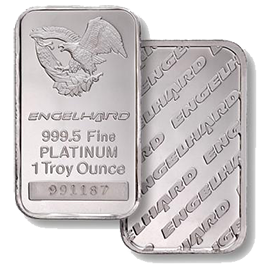
PLATINUM
Platinum is derived from the term “platina del Pinto” which translates into “little silver of the Pinto River” in Spanish.
It is a pure metal, 30x rarer than gold, silvery-white, lustrous, ductile, malleable and almost 40% heavier than 18 karat gold.
It does not oxidize at any temperature making Platinum “hypoallergenic” and as such is considered a noble metal. Among the main advantages of Platinum for jewellery fabrication is its strength and resistance to tarnish. Platinum does make certain demands on the Jewellers skills. It requires high temperature melting and casting equipment (melting at 1750+ °C / 3200+°F) and a scrupulously clean working environment. Careful attention to polishing techniques is needed to achieve the highly reflective finish which shows a Diamond or other precious Gemstone at its best. Platinum will also develop a patina texture with wear over time.
North American platinum is 90% or 95% pure commonly alloyed with Ruthenium or Iridium also from the Platinum family to optimize its working properties and carries the Metal Purity stamp: PT 900 or PT 950.
It is currently mined in Canada, Russia and South Africa.
PRECIOUS METALS
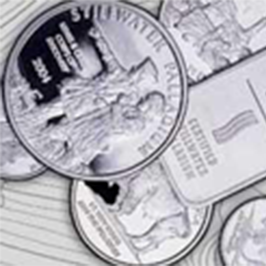
PALLADIUM
Palladium from the Greek name "Pallas", goddess of Wisdom, was discovered by the British chemist William Hyde Wollaston in 1803. It is whiter, lighter and about 12% harder than Platinum. A rare and ductile metal Palladium has been used as an alternative to platinum or white gold as a precious metal in jewellery since 1939 due to its “hypoallergenic” properties. Similar to gold, Palladium can be beaten to form a leaf as thin as 1/250,000 inch.
As it is also lighter than Platinum, nearly half the weight, more intricate designs can be manufactured incorporating larger Gemstones with minimal overall weight gain. Palladium jewellery is usually 95% pure Palladium with the remainder being Ruthenium, another Platinum group metal or even Gold making Palladium “hypoallergenic” and as such is considered a noble metal.
Palladium will also develop a patina texture with wear over time and carries the Metal purity stamp: Pd 950
Increasing consumer awareness has made Palladium extremely popular for jewelry and is presently being mined in Russia, Canada, South Africa and the United States.
PRECIOUS METALS
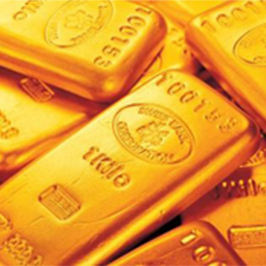
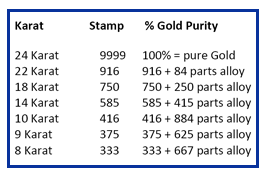
GOLD
Gold is a highly sought-after precious metal known since prehistoric times. It may have been the first metal used by humans and was valued for ornamentation and rituals. As early as 2600 BC Gold was claimed to be "more plentiful than dirt" in ancient Egypt and is considered the King of all metals.
The native metal occurs as nuggets or grains in rocks. Gold is dense, soft, shiny and does not easily tarnish making it the most malleable and ductile of all metals. A single gram can be beaten into a sheet of 1 square meter and thin enough to become translucent
Pure gold has a bright yellow color and lustre, traditionally considered attractive and because of the softness of pure gold it is usually alloyed with other metals for use in jewellery altering its hardness and ductility, melting point, color and other properties.
The gold proportion is expressed in karats (K or KT). The higher the Karat mark the greater percentage of pure Gold to Alloy is present in your Jewellery. White Gold is pure gold alloyed with at least one white metal like Palladium or Nickel, Rouge Gold (Pink, Rose) is an alloy of gold and copper and Green Gold is an alloy of gold and silver.
Gold is presently mined in the United States, Canada, Russia, South Africa, Australia and South America.
PRECIOUS METALS
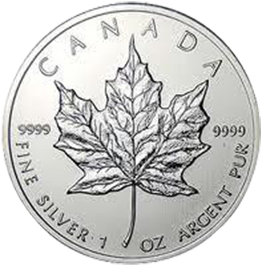
SILVER
Silver from the ancient Latin word "argentum" was discovered as early as the 4th millennium BC and has long been valued as a precious metal.
An extremely ductile and malleable metal with a brilliant white metallic lustre, silver can take a high degree of polish. The beauty, weight and lack of corrosion made silver one of the earliest metals to be used as a medium of exchange (coins) since the 14th century.
It also has the highest electrical conductivity of all metals. Jewellery, high-value tableware, utensils (hence the term silverware) and currency are traditionally made from Sterling Silver an alloy of 92.5% Silver and 7.5% copper. Sterling Silver is a standard in many countries and has a metal purity stamp of: STERLING or 925.
The major Silver mines are in South America, China, Australia and North America.